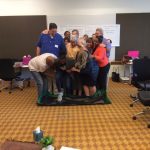
Circle in Action
In the fall of 2021 MECC was introduced to two pastors from a local Methodist church to support them and their team on a healing journey. In the midst of the disruption of the global pandemic, one of their assistant pastors had suffered a tragic car accident. The pastor was a light to so many through his ministry and through his presence. He was a devoted dad and had a magnetic and dynamic personality. He had survived and was facing a long road of recovery.
The staff at the church continued to forge ahead, with each person experiencing the grief of losing the colleague they had come to love. The challenge of missing him, supporting his family and his recovery, and carrying forward his work was a tall order for the team. There comes a time when those who do the ministering and the holding of the grief for others need to be held themselves.
After meeting with the two pastors at the church to understand the crossroads that they and the staff were experiencing, MECC identified healing circles as the means to allow for a collective “exhale”, a first step in acknowledging that the team had been holding its breath since hearing of the accident. The healing circles were designed to allow the team a sigh of relief; creating a space where the team could collectively name and process their own grief and learn about how and where they each fit into a changing and evolving church system.
Circle is an ancient practice that people and communities have used since time immemorial to come together. As shared by the Circle Way, “circle started around the cook-fires of humanity’s ancestors and has accompanied us ever since. We remember this space. When we listen, we speak more thoughtfully. We lean in to shared purpose.”
Circle felt like the natural path forward for the team with a shared purpose to be a healing salve for each other. In the practice of circle, we sit shoulder-to-shoulder (socially distanced shoulders in this case) with the understanding that everyone plays a role in supporting the whole. Circle allows us to speak our feelings and experiences into the center of the circle to be witnessed, without a need to hide it, fade it, fix it or even respond to what is shared.
Selecting a time when the flurry of church activity had quieted, the team came together to share a meal and begin a journey of healing. During the first circle, Meghan and Kristi held the space to allow the team to process their individual grief, sorrow, happiness, guilt and joy. Though we often do not acknowledge or realize it, grief and joy are inextricably connected. To truly know and experience the heights of joy, we must allow ourselves to experience the profound depths of grief. Because we are often afraid of our pain and sorrow as well as that of others, we often snuff or dim our own joy or happiness. It’s a phenomenon called foreboding joy. As Brene Brown put it in the Gifts of Imperfection, “The dark does not destroy the light; it defines it. It’s our fear of the dark that casts our joy into the shadows.” Understanding how and why both can (and should) coexist allows us to experience our feelings without guilt or shame. With tears and laughter, the team spoke to the sorrow and joys they were experiencing. It felt as though everyone breathed a little deeper by the end of the evening.
The second circle allowed for continued conversation about processing grief, exploring self-care, and for a deeper exploration into systems with the Two Loops Theory of Change. Any organization (including churches) are systems that experience change as people move in and out of their roles of leadership, support, and more. Exploring this model allowed the team to contextualize the changes happening around and amongst them.
Being invited into this sacred space to guide this team was amongst the deepest and profoundly moving work we experienced in 2021. The result was more than we could have imagined. After a collective exhale, the staff shared their experience with the congregation and then hosted a series of healing circles with their parishioners, collectively processing their own losses experienced during the pandemic and more.
“Each person’s grief is as unique as their fingerprint. But what everyone has in common is that no matter how they grieve, they share a need for their grief to be witnessed. That doesn’t mean needing someone to try to lessen it or reframe it for them. The need is for someone to be fully present to the magnitude of their loss without trying to point out the silver lining.”
– David Kessler, Finding Meaning: The Sixth Stage of Grief
Access the Guide to Circle Way or the Guide to Hosting Virtual Grief Circles



